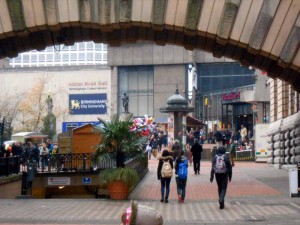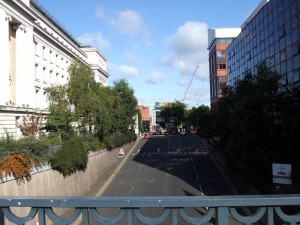Alan Clawley writes: “We are not alone in being sceptical about the ability of the Local Enterprise Partnership (LEP) and the RZ to rescue developments like Paradise Circus.”
When a delegation of Friends of the Central Library met Councillor McKay in August in the Council House he quoted the Brundtland Commission and its emphasis on safeguarding the quality of life of future generations. He supported the Cabinet’s view that the comprehensive redevelopment of Paradise Circus and the resulting creation of new jobs and prosperity can only be achieved by demolishing the existing buildings, including the redundant Library building rather than retaining them.
Since then we have been trying without success to extract from the Council the evidence that supports this grandiose claim. We started an e-petition on the Council website in June, submitted a Freedom of Information request on 23 August and asked the Council Leader an oral question on 16 October. My FoI request asked for,
- A – Copies of any documents that indicate the number of people who worked in (were employed in) Paradise Circus between 2000 and 2007. Paradise Circus includes the Central Library, School of Music, Fletchers Walk, Paradise Forum, Copthorne Hotel, Chamberlain House, Office no.77 and the Yardbird Pub.
- B – Copies of any documents that indicate the projected number of people who will work in Paradise Circus after the proposed redevelopment has been completed, whenever that may be.
 At the end of September a letter from Mrs Saroj Rama, the Council’s Corporate Information Governance officer informed me, ‘The only information Birmingham City Council hold on how many people employed [sic] in the Central Library or Chamberlain House in Paradise Circus, is contained within the Environmental Statement accompanying the outline planning application for Paradise Circus;
At the end of September a letter from Mrs Saroj Rama, the Council’s Corporate Information Governance officer informed me, ‘The only information Birmingham City Council hold on how many people employed [sic] in the Central Library or Chamberlain House in Paradise Circus, is contained within the Environmental Statement accompanying the outline planning application for Paradise Circus;
- Existing jobs estimated at 1,059 – this is only an estimate based on density of development calculations.
- Predicted total FTE jobs 9,898 – this is based on the minimum floor space figures, so there could well be more.’
Mrs Rama went on to say: ‘The other buildings you have mentioned are private businesses and therefore we would not hold any information.’
I wrote back to Mrs Rama to point out there were no documents attached to her letter and that it would have been helpful if she had told me which of the 32 Environmental statements in the planning application she referred to.
The reply came from the Senior Governance Officer, Dean Robinson, on 4 October, who stated: ‘I am currently trying to locate any information that estimates the net benefit of redeveloping Paradise Circus.’
I wrote back (11 October) saying that what I had received was far from satisfactory as the only documents offered had been produced by the consultants employed by Argent plc and not by the City Council and Mrs Rama had not identified the source of the figures which she quoted in her letter. As I am still (2 December) waiting for an answer, I feel entitled to draw the conclusion that no such documents exist or if they do, they do not support the Council’s case.
Our e-petition calling on the Council to re-think its policy, was signed by 688 people in the space of one month. We are still waiting for the Council’s Development and Culture Directorate to respond.
Councillor Bore’s reply to my oral question is on the Council’s website. He concedes that ‘the cyclical nature of market conditions gives rise to effects which sometimes encourage the provision of new commercial space, whilst at other times discourage its provision’, but he didn’t say where Birmingham was in this cycle. With touching faith in the professionals he endorsed ‘the consensus view from the property consultants that the supply of new Grade A offices in Birmingham City Centre would be exhausted somewhere between 2014 and 2016’.
Cllr Bore ignored the fact that perfectly good Grade A offices can be provided by adapting existing buildings, but he has long argued that knocking everything down was the only solution, driven, in his own admission, by a personal dislike of ‘brutalist’ architecture.
The lack of supporting evidence highlights the weakness in the current economic case for comprehensive redevelopment. The state of the market dictates that the whole site will not be completed for 15 years and nothing will be built without firm commitments from future tenants. Now the Council and their chosen developer are hoping for public funding from the City Centre Regeneration Zone to make up the shortfall in capital finance.
We are not alone in being sceptical about the ability of the Local Enterprise Partnership (LEP) and the RZ to rescue developments like Paradise Circus. LibDem MP John Hemming, quoted in the Birmingham Post, 28 September, ‘Britain should stop relying on economic growth to create jobs and instead look for ways of sharing out the limited amount of work available’ whilst the headline above Labour Councillor John Clancy’s article in the Birmingham Post (9 November) reads ‘I fear the LEP is dreaming’. He goes on, ‘The LEP as currently configured is based on outdated, pre-financial crash notions and a misplaced faith in private sector finance and private sector growth. It is not based on the financial and economic reality of now.’
Perhaps Councillor Clancy should have a word in his Leader’s ear before its too late.



